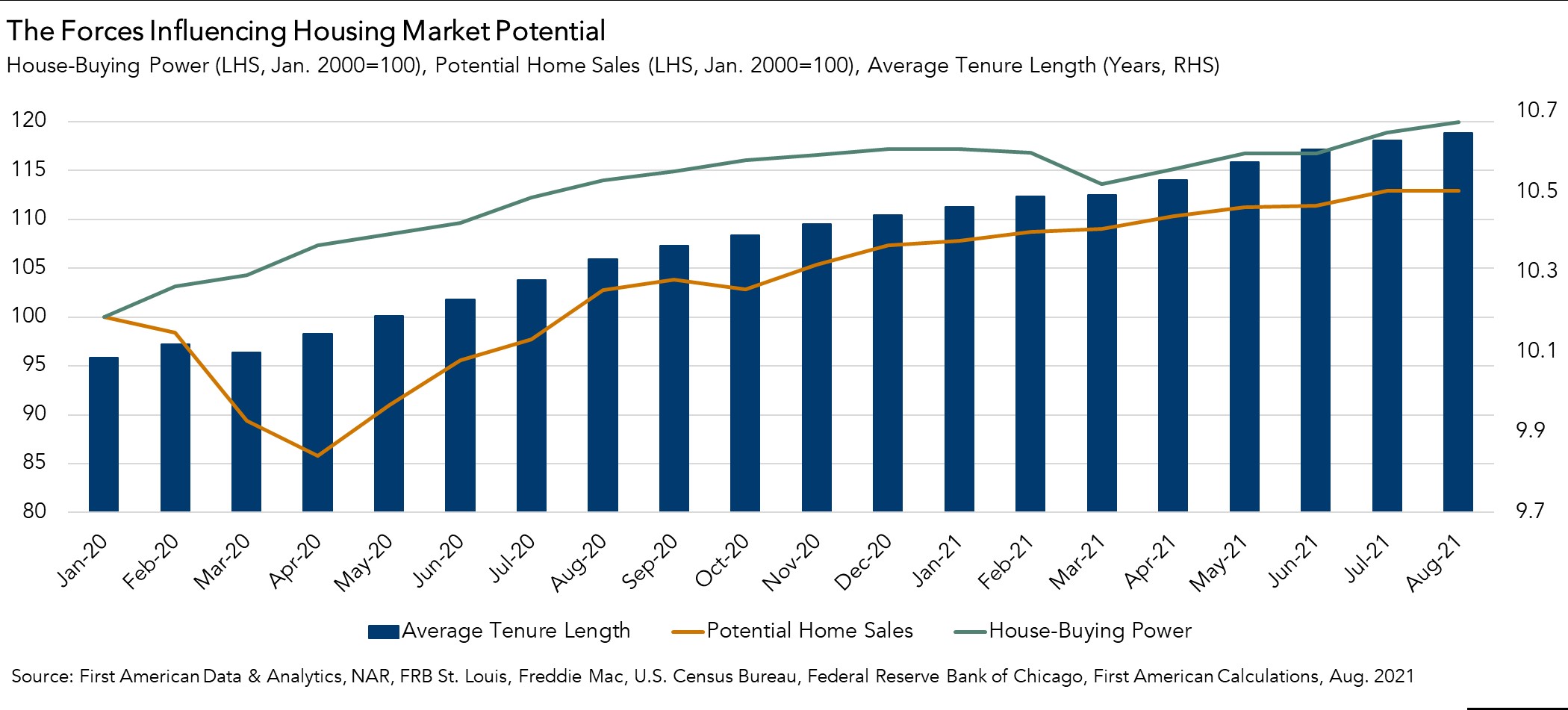Housing market potential continued to strengthen in August, according to our Potential Home Sales Model, increasing 0.05 percent compared with July. The market potential for existing-home sales is now nearly 10 percent higher than in August of 2020, when the housing market’s summer rebound was ramping up following the initial pandemic-driven decline in the spring.
“While the economy may be taking a ‘Delta dip,’ the unexpected burst of increased house-buying power has boosted housing market potential.”
This past year has shown us that the economy follows the path of COVID-19, and that was evident in August’s labor market data. The labor market recovery stalled, as the resurgent pandemic discouraged workers from re-entering the labor force. Additionally, consumer confidence fell to a six-month low as worries about rising COVID-19 infection rates weighed on consumers’ outlook for the economy. But is increased economic uncertainty bad news for housing market potential? Not necessarily.
Uncertainty Boosts House-Buying Power
In August, house-buying power increased 0.9 percent compared with July due to a 0.03 percentage point decrease in the 30-year, fixed mortgage rate and a 0.5 percent increase in median household income. Lower than anticipated labor force participation, combined with increased demand for labor, is increasing the pace of wage growth. The month-over-month jump in household income contributed to a $2,800 increase in house-buying power. Additionally, the decline in mortgage rates contributed to a $1,700 increase in house-buying power in August. The total $4,500 increase in house-buying power boosted market potential by approximately 19,000 potential home sales.
There Are Still Forces Pushing Back
Tightening Credit: A downside of increased economic uncertainty that directly impacts housing is the potential for tightening credit conditions. When lending standards are tighter, fewer people can qualify for a mortgage, dampening first-time home buyer demand and increasing the likelihood that some homeowners stay in their current homes because they are ineligible for a new mortgage. In August, while credit conditions remained looser than average, they did tighten relative to July. Tighter credit conditions reduced potential home sales by approximately 54,000 compared with one month ago.
Lack of Supply: The average length of time someone lives in their home increased in August relative to July, trimming housing market potential by over 7,000 potential home sales. While low mortgage rates can spur home-buying demand by reducing the monthly cost of a mortgage and increasing house-buying power, many existing owners who have refinanced into even lower mortgages are less incentivized to move. Approximately two-thirds of all home buyers are existing homeowners, so fewer homeowners listing their homes reduces housing supply.

It’s Complicated
The housing market’s relationship with this pandemic economy is complicated. While heightened economic uncertainty dims consumer confidence and may result in tighter credit, it also puts downward pressure on mortgage rates. The shortage of labor supply relative to the growing demand for labor has fueled household income growth. While the economy may be taking a “Delta dip,” the unexpected burst of increased house-buying power has boosted housing market potential.
August 2021 Potential Home Sales
For the month of August, First American updated its proprietary Potential Home Sales Model to show that:
- Potential existing-home sales increased to a 6.40 million seasonally adjusted annualized rate (SAAR), a 0.05 percent month-over-month increase.
- This represents an 83.5 percent increase from the market potential low point reached in February 1993.
- The market potential for existing-home sales increased 9.9 percent compared with a year ago, a gain of 575,700 (SAAR) sales.
- Currently, potential existing-home sales is 392,200 (SAAR), or 5.8 percent below the pre-recession peak of market potential, which occurred in April 2006.
Market Performance Gap
- The market for existing-home sales outperformed its potential by 6.4 percent or an estimated 407,600 (SAAR) sales.
- The market performance gap increased by an estimated 92,500 (SAAR) sales between July 2021 and August 2021.
First American Deputy Chief Economist Odeta Kushi contributed to this post.
What Insight Does the Potential Home Sales Model Reveal?
When considering the right time to buy or sell a home, an important factor in the decision should be the market’s overall health, which is largely a function of supply and demand. Knowing how close the market is to a healthy level of activity can help consumers determine if it is a good time to buy or sell, and what might happen to the market in the future. That is difficult to assess when looking at the number of homes sold at a particular point in time without understanding the health of the market at that time. Historical context is critically important. Our potential home sales model measures what we believe a healthy market level of home sales should be based on the economic, demographic, and housing market environments.
About the Potential Home Sales Model
Potential home sales measures existing-home sales, which include single-family homes, townhomes, condominiums and co-ops on a seasonally adjusted annualized rate based on the historical relationship between existing-home sales and U.S. population demographic data, homeowner tenure, house-buying power in the U.S. economy, price trends in the U.S. housing market, and conditions in the financial market. When the actual level of existing-home sales are significantly above potential home sales, the pace of turnover is not supported by market fundamentals and there is an increased likelihood of a market correction. Conversely, seasonally adjusted, annualized rates of actual existing-home sales below the level of potential existing-home sales indicate market turnover is underperforming the rate fundamentally supported by the current conditions. Actual seasonally adjusted annualized existing-home sales may exceed or fall short of the potential rate of sales for a variety of reasons, including non-traditional market conditions, policy constraints and market participant behavior. Recent potential home sale estimates are subject to revision to reflect the most up-to-date information available on the economy, housing market and financial conditions. The Potential Home Sales model is published prior to the National Association of Realtors’ Existing-Home Sales report each month.


.jpg)
